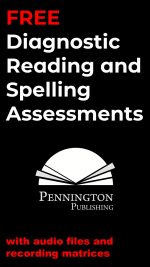How to Teach the Common Core Spelling Standards
What do the Common Core authors have to say about spelling instruction?
The spelling Standards for Grades 4‒8 are as follows:
“Spell grade-appropriate words correctly, consulting references as needed.” (L.4.2e, L.5.2e)
“Spell correctly.” (L.6.2b, L.7.2b, L.8.2b)
Although lacking specificity in the Language Strand, the Common Core approach to spelling instruction is detailed in the Orthography section of Appendix A. This section includes examples of the sound-spelling patterns, syllable rules, and derivational suffixes (20‒22). Additionally, the K‒5 Reading: Foundational Skills Standards all require direct instruction of the phoneme-grapheme (spelling) correspondences (Reading: Foundational Skills) In other words, phonics and spelling.
The focus on spelling patterns draws heavily from the research of Dr. Louis Cook Moats, such as in Moats, L. C. (2008). Spellography for teachers: How English spelling works. (LETRS Module 3). Longmont, CO: Sopris West.
How to Teach the Common Core Spelling Standards
*****
My Grammar, Mechanics, Spelling, and Vocabulary program includes a grade-level spelling patterns program with weekly spelling tests and spelling sorts. Students review previous grade-level spelling patterns and are introduced to new grade-level spelling patterns (including derivational and etymological influences) throughout the weekly lessons. Students create Personal Spelling Lists from those words missed on the weekly diagnostic spelling tests, from words misspelled in their own writing, and from the spelling resources provided in the program Appendix. The program also provides a complete syllabication program with syllable and derivatives worksheets.
Additionally, the program provides a comprehensive remedial spelling program tied to the Diagnostic Spelling Assessment. Each grade-level diagnostic assessment varies in complexity to test all previous grade-level spelling patterns and takes about 20 minutes to administer.
Students complete remedial Spelling Pattern Worksheets for each unmastered spelling pattern as indicated by the test. Worksheets include the focus spelling pattern or spelling rule with examples, a spelling sort, word jumbles, and rhymes or book searches for the focus spelling pattern. Students self-correct and self-edit their answers from answer sheets to learn from their own mistakes. Finally, students complete a quick formative assessment labeled “Write” at the bottom of the worksheet to see if they can apply the focus spelling pattern within their own writing. Students mini-conference with the teacher and the teacher reviews the formative “Write” assessment. If mastered, the students record that mastery on the class recording matrix as detailed in the Grammar, Usage, and Mechanics section above. If not yet mastered, the teacher briefly re-teaches the spelling pattern and students try the formative assessment until mastery has been demonstrated.
Grammar, Mechanics, Spelling, and Vocabulary helps students learn the grade-level spelling patterns, the syllable rules, and the derivational spelling influences of our English orthography. The program also has the resources teachers need to individualize remedial spelling patterns‒exactly as described by the Common Core authors.
*****
Or why not get the value-priced Grammar, Mechanics, Spelling, and Vocabulary (Teaching the Language Strand) grades 4, 5, 6, 7, and 8 BUNDLES? These grade-level programs include both teacher’s guide and student workbooks and are designed to help you teach all the Common Core Anchor Standards for Language. In addition to the Teaching Grammar and Mechanics program, each BUNDLE provides weekly spelling pattern tests and accompanying spelling sort worksheets (L.2), 56 language application opener worksheets (L.3), and 56 vocabulary worksheets with multiple-meaning words, Greek and Latin word parts, figures of speech, word relationships with context clue practice, connotations, and four square academic language practice (L.4, 5, and 6). Comprehensive biweekly unit tests measure recognition, understanding, and application of the grammar, mechanics, and vocabulary components.
The program also has the resources to meet the needs of diverse learners. Diagnostic grammar, usage, mechanics, and spelling assessments provide the data to enable teachers to individualize instruction with targeted worksheets. Each remedial worksheet (over 200 per program) includes independent practice and a brief formative assessment.
Check out the brief introductory video and enter DISCOUNT CODE 3716 at check-out for 10% off this value-priced program. We do sell print versions of the teacher’s guide and student workbooks. Contact mark@penningtonpublishing.com for pricing. Read what teachers are saying about this comprehensive program:
The most comprehensive and easy to teach grammar, mechanics, spelling, and vocabulary program. I’m teaching all of the grade-level standards and remediating previous grade-level standards. The no-prep and minimal correction design of this program really respects a teacher’s time. At last, I’m teaching an integrated program–not a hodge-podge collection of DOL grammar, spelling and vocabulary lists, and assorted worksheets. I see measurable progress with both my grade-level and intervention students. BTW… I love the scripted lessons!
─Julie Villenueve

 As an MA Reading Specialist and author of quite a few spelling curricula (eight at last count), I’m often asked about spelling word lists by grade levels.
As an MA Reading Specialist and author of quite a few spelling curricula (eight at last count), I’m often asked about spelling word lists by grade levels. 


